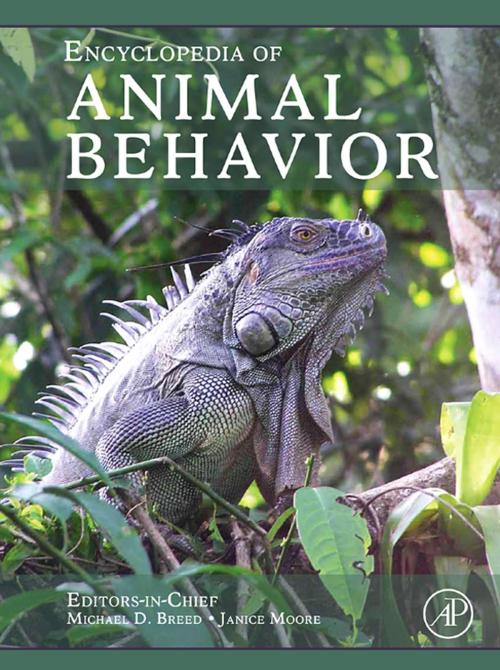Encyclopedia of Animal Behavior
Nonfiction, Science & Nature, Science, Biological Sciences, Ecology, Zoology| Author: | Michael D. Breed, Janice Moore | ISBN: | 9780080453378 |
| Publisher: | Elsevier Science | Publication: | April 1, 2009 |
| Imprint: | Academic Press | Language: | English |
| Author: | Michael D. Breed, Janice Moore |
| ISBN: | 9780080453378 |
| Publisher: | Elsevier Science |
| Publication: | April 1, 2009 |
| Imprint: | Academic Press |
| Language: | English |
The Encyclopedia of Animal Behavior has engaged with great success the efforts of many of the best behavioral biologists of the 21st century. Section editors drawn from the most accomplished behavioral scientists of their generation have enrolled an international cast of highly respected thinkers and writers all of whom have taken great care and joy in illuminating every imaginable corner of animal behavior.
This comprehensive work covers not only the usual topics such as communication, learning, sexual selection, navigation, and the history of the field, but also emerging topics in cognition, animal welfare, conservation, and applications of animal behavior. The large section on animal cognition brings together many of the world's experts on the subject to provide a comprehensive overview of this rapidly developing area. Chapters relating to animal welfare give a full view of behavioral interactions of humans with companion animals, farm animals, and animals in the wild. The key role of animal behavior in conservation biology receives broad attention, including chapters on topics such as the effects of noise pollution, captive breeding, and how the behavioral effects of parasites interacts with conservation issues. Animal behavior in environmental biology is highlighted in chapters on the effects of endocrine disruptors on behavior and a large number of chapters on key species, such as wolves, chimpanzees, hyenas and sharks.
Clear, accessible writing complements a wealth of information for undergraduate college students about the essential concepts of animal behavior and the application of those concepts across the field. In-depth coverage of concepts, methods, and exemplar organisms serves the needs of graduate students and professionals in the field.
From the use of behavior in assessing the welfare of pigs to the social behavior of insects, from animal empathy to bat brains, this authoritative reference, with its in-depth introductory articles, rich array of illustrations, interactive cross-referenced links, and numerous suggested readings, can guide the student or the professional to an expanded appreciation of the far-flung world of animal behavior. An invaluable tool for teaching and a source of enrichment and detail for any topic covered in an animal behavior course, the Encyclopedia of Animal Behavior is the definitive reference work in its field and will be for years to come.
- Comprehensive work which covers the usual topics along with emerging areas of animal behavior
- This encyclopedia contains clear, accessible writing and is well illustrated, including an online video, complimenting a wealth of information
- As an online reference, this work will be subject to period updating. This ensures that the work always remains current
- Contains in-depth introductions to the material that make each well-illustrated section come alive with the best the new content the discipline has to offer
- Glossary includes a compendium of behavioral terms that form a succinct mosaic of virtually every concept and phenomenon related to animal behavior
- Section editors, drawn from around the world, represent the best and the brightest among today's behavioral biologists and have recruited a broad range of internationally recognized experts
- Editors-in-Chief are experienced scientists and writers who between them have authored or edited eight books and teach courses in animal behavior at their respective universities
The Encyclopedia of Animal Behavior has engaged with great success the efforts of many of the best behavioral biologists of the 21st century. Section editors drawn from the most accomplished behavioral scientists of their generation have enrolled an international cast of highly respected thinkers and writers all of whom have taken great care and joy in illuminating every imaginable corner of animal behavior.
This comprehensive work covers not only the usual topics such as communication, learning, sexual selection, navigation, and the history of the field, but also emerging topics in cognition, animal welfare, conservation, and applications of animal behavior. The large section on animal cognition brings together many of the world's experts on the subject to provide a comprehensive overview of this rapidly developing area. Chapters relating to animal welfare give a full view of behavioral interactions of humans with companion animals, farm animals, and animals in the wild. The key role of animal behavior in conservation biology receives broad attention, including chapters on topics such as the effects of noise pollution, captive breeding, and how the behavioral effects of parasites interacts with conservation issues. Animal behavior in environmental biology is highlighted in chapters on the effects of endocrine disruptors on behavior and a large number of chapters on key species, such as wolves, chimpanzees, hyenas and sharks.
Clear, accessible writing complements a wealth of information for undergraduate college students about the essential concepts of animal behavior and the application of those concepts across the field. In-depth coverage of concepts, methods, and exemplar organisms serves the needs of graduate students and professionals in the field.
From the use of behavior in assessing the welfare of pigs to the social behavior of insects, from animal empathy to bat brains, this authoritative reference, with its in-depth introductory articles, rich array of illustrations, interactive cross-referenced links, and numerous suggested readings, can guide the student or the professional to an expanded appreciation of the far-flung world of animal behavior. An invaluable tool for teaching and a source of enrichment and detail for any topic covered in an animal behavior course, the Encyclopedia of Animal Behavior is the definitive reference work in its field and will be for years to come.
- Comprehensive work which covers the usual topics along with emerging areas of animal behavior
- This encyclopedia contains clear, accessible writing and is well illustrated, including an online video, complimenting a wealth of information
- As an online reference, this work will be subject to period updating. This ensures that the work always remains current
- Contains in-depth introductions to the material that make each well-illustrated section come alive with the best the new content the discipline has to offer
- Glossary includes a compendium of behavioral terms that form a succinct mosaic of virtually every concept and phenomenon related to animal behavior
- Section editors, drawn from around the world, represent the best and the brightest among today's behavioral biologists and have recruited a broad range of internationally recognized experts
- Editors-in-Chief are experienced scientists and writers who between them have authored or edited eight books and teach courses in animal behavior at their respective universities















